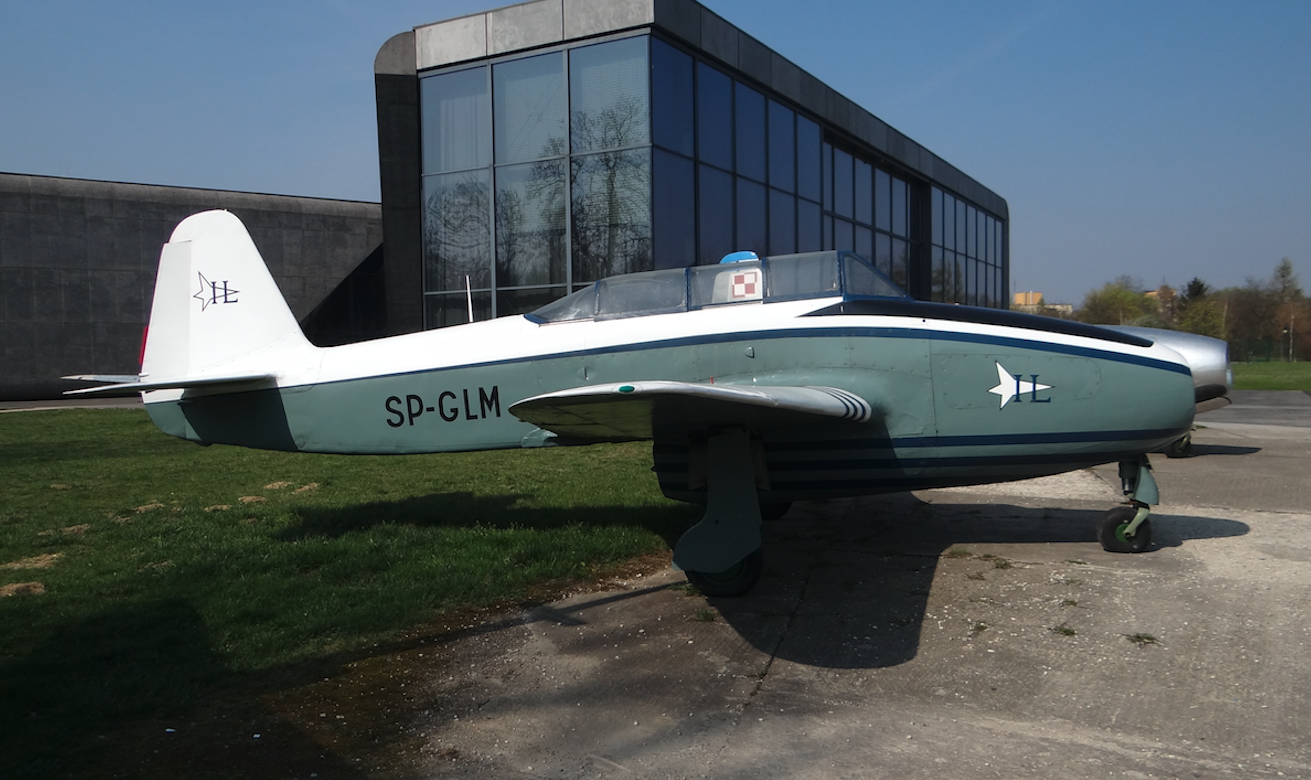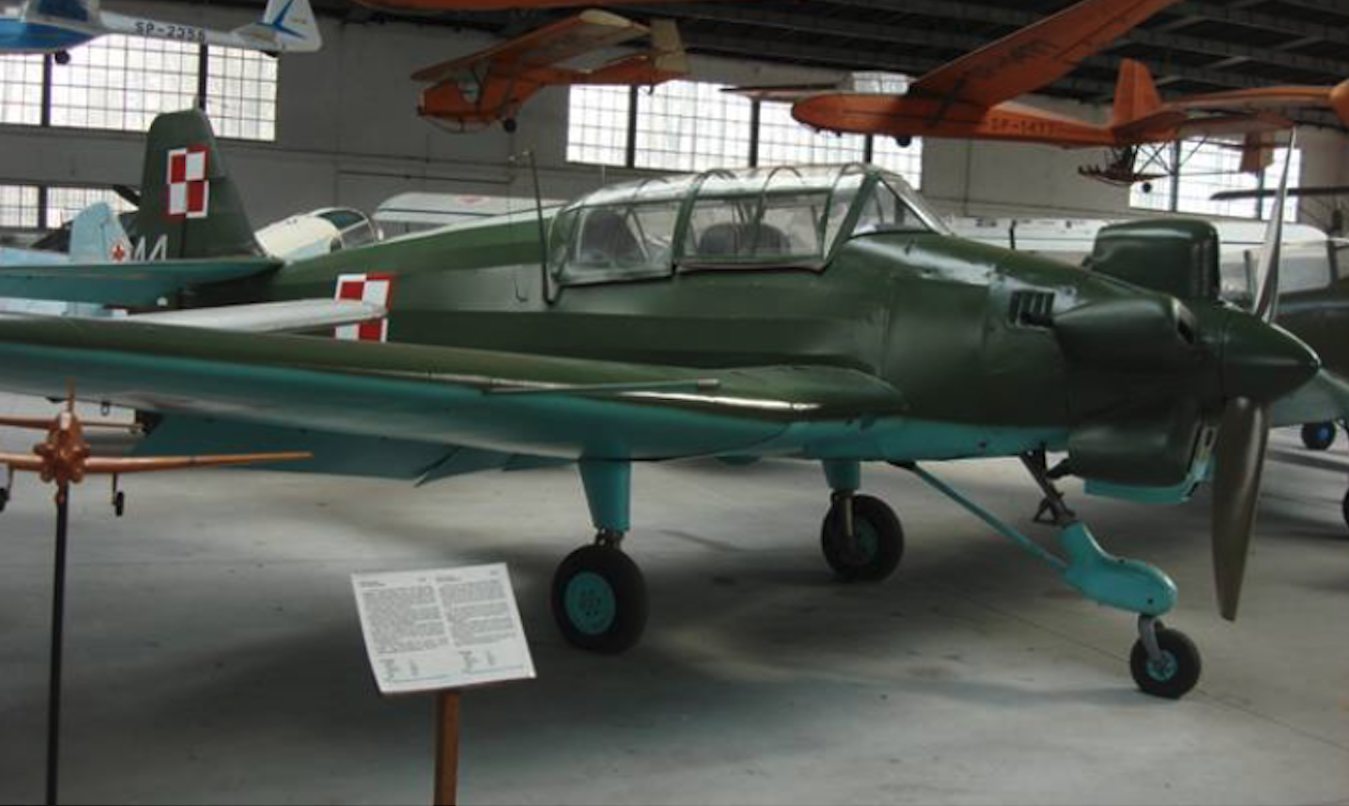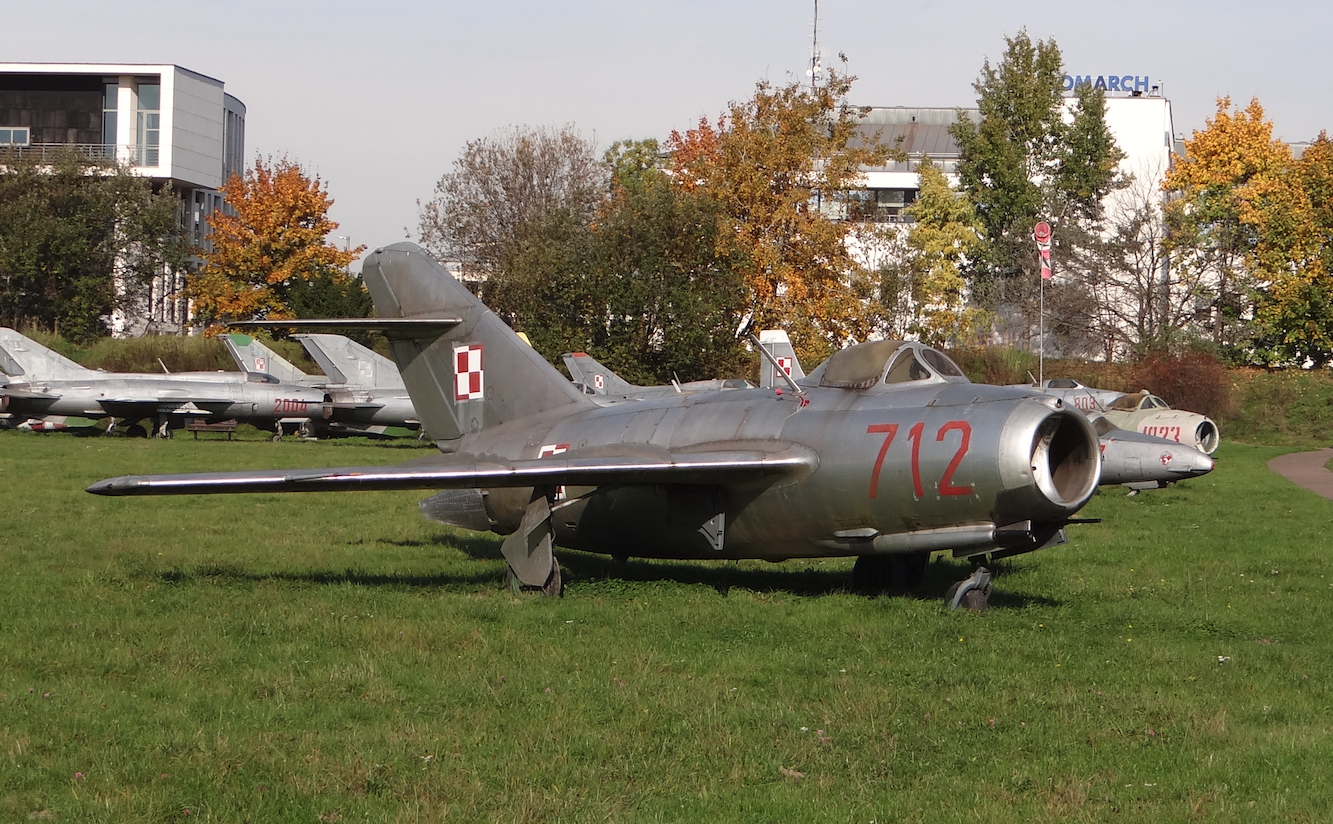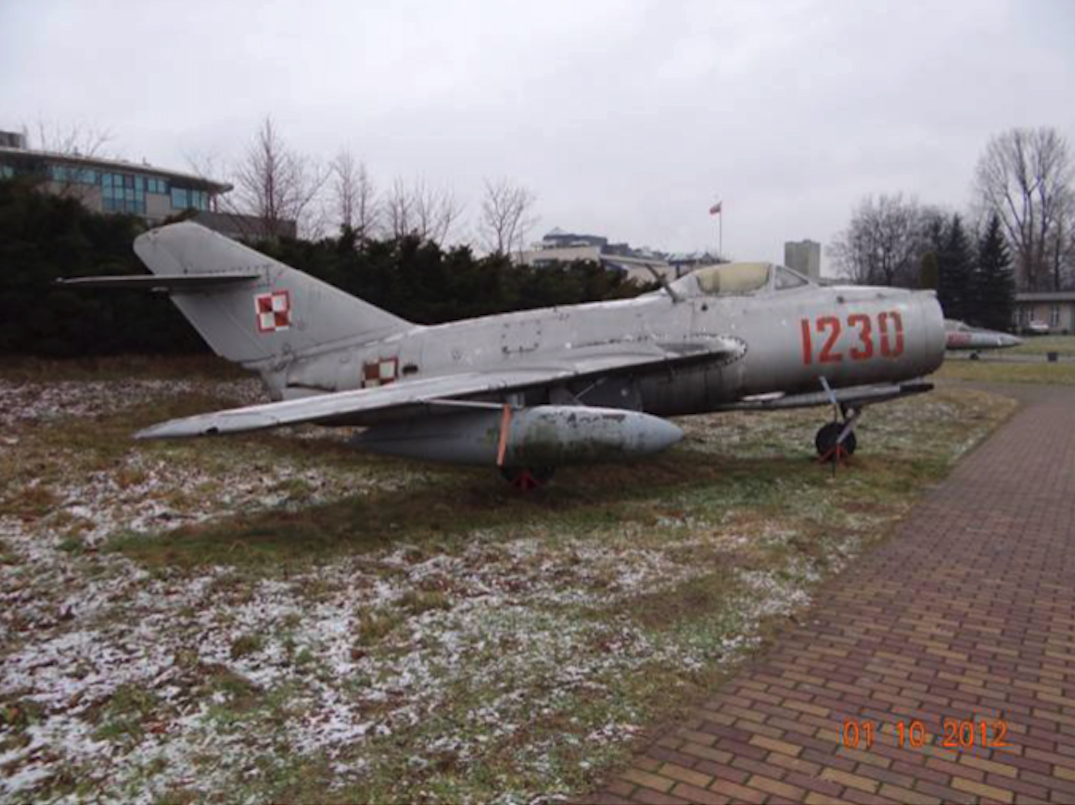Kraków 2012-03-20
Państwowe Zakłady Lotnicze – Communication Equipment Factory – Mielec.
1950-1956. Part 2.
Jakowlew Jak-17. 1949 year.
In 1948, a seven-year plan for the development of military aviation for the period 1949-1955 was developed in Poland. These plans included the acquisition of new fighter planes driven by future-oriented turbojet engines. Since Poland was relentlessly falling into the zone of influence of the new occupant, only the Soviet Union could be the only supplier of new equipment. The purchase of Jak-15 aircraft was considered, but the CCCP did not dare to sell these aircraft, even to dependent countries. The Jak-15 aircraft was exceptionally emergency and the flight time did not exceed 15 minutes. The purchase of the Jak-17 and Jak-17 W airplanes, which is a training version, turned out to be feasible. At the beginning of 1950, Poland purchased the first batch of Jak-17 fighters, consisting of three machines. The planes were brand new. These machines were delivered to Radom by one railroad. The first Polish Jak-17 aircraft was assembled in July 1950.
At the turn of 1949/1950, the possibility of launching the licensed production of Jak-17 aircraft by the domestic aviation industry was considered in Poland. In the mid-1950s, preparations for this production began, with the third purchased one-seat Jak-17 at their disposal. The plane was to be designated PZL Mielec G-1. The designation PZL-Mielec G-1 U was to be given to the two-seater version, i.e. the Jak-17 W Agata. The works were supervised by the main constructor of the Mielec factory, Eng. Zygmunt Szczeciński. He organized a team led by engineer Stanisław Lipiński. The team developed construction and technological documentation and the assembly of the first five prototypes was started. The assembly was not completed, as work on the Jak-23 plane began.
At the same time, preparations were made at WSK in Rzeszów to start the license production of RD-10 A engines under the name G-2. These plans were also abandoned. Only 30 copies were made, and they were used to power the operated Jak-17 W airplanes.
Jakovlev Jak-23. 1951.
At the beginning of 1951, the plans of the Polish government on the development of the Polish Military Aviation and the purchase of a license for the production of Jak-23 were ready. In February 1951, a decision was made to suspend work on starting the production of the G-1 (Jak-17) fighter, and to start work on preparing the G-3 (Jak-23) for license production.
At that time, the development of defense was still closely related to the economic development of the country destroyed after the war. This purchase was logical. Therefore, one complete plane was sent to Mielec from the CCCP, which was to be used as a model. The plane was heavily guarded. Before the start of serial production, few people had access to the aircraft. It was planned to produce wings and the rear part of the fuselage in Mielec, and the front part in Świdnik. The engines were to be supplied directly from the CCCP.
The production was not undertaken as the plans were changed once again and the MiG-15 planes were introduced. The progress of the works to start production is evidenced by the fact that about 25 tons of sheets were sent for scrap, not counting those sheets that were reused.
LWD CSS Junak-2.
A team of LWD designers has developed a successful Junak training and training aircraft. After trials, in 1949, an improved variant of the Junak 2 was developed and tested, with better equipment for the military and good pilot properties, which was then put into production in 1951. Its production was placed in PZL-Mielec. However, only 3 copies were built in Mielec, because the entire production was moved to Warsaw, where 105 Junak 2 aircraft were built. The reason was to place the production of military fighter planes in Mielec. In the meantime, the LWD team was disbanded in 1949 and the refinement of the Junak 2 was taken over by the Central Aircraft Study (CSS) workshop in Warsaw. Junak-3 was soon built.
Lim-1. MiG-15. 1952 year.
In connection with the war in Korea, the Russians decided to rearm the "allied" armies. Their industry, however, was not able to build a sufficiently large number of fighters in a sufficiently short time. They had to take the risk and hand over the licenses of their newest and best fighters. In Poland, preparations for the construction of fighters were suspended at that time; Yak-17 (G-1), Yak-23 (G-3), RD-10 (G-2) engines. On the basis of the resolution of the Polish Government of June 19, 1951, No. 12, it was decided to implement the plan to purchase a license for the production of MiG-15 fighters. The interwar COP (Central Industrial District) was selected as the production site, including Mielec, Świdnik and Rzeszów. The plant in Okęcie and several smaller auxiliary production plants were also expanded.
The Polish aircraft was designated as Lim-1, abbreviated to License Myśliwiec construction No. 1. The program was headed by engineer Zygmunt Szczeciński. The assumptions were as follows; The basic factory was to be the newly built WSK Świdnik plant. The construction of the plant began in 1949. Part of the airframe production was to be located in Mielec. The engines were to be produced by the WSK Rzeszów plant. The final assembly was to be carried out by WSK Świdnik.
Here are a few words of explanation about the abbreviation WSK. This abbreviation stands for the Communication Equipment Factory. This name was a disguise of the military nature of the production. The name Państwowe Zakłady Lotnicze is easily associated with airplanes, and therefore with the possible production of combat aircraft. Nevertheless, the name PZL Mielec functioned invariably in everyday conversations.
Construction of plants in Świdnik.
On January 1, 1951, the Central Management Board of the Communication Equipment Industry in Warsaw, based on the Resolution of the Council of Ministers, Order of the Minister of Heavy Industry of December 14, 1950, established the WSK Plant No. 5 in Świdnik. The greatest intensity of construction works took place in the period 1950-1953. The first halls were built in the period 1950-1952, from structures transferred from Krzesiny near Poznań, and from 1953, basic production, auxiliary and service facilities were put into use.
The process of building the factory in Świdnik, by nature, had to last several years, and the planes were needed as soon as possible. That is why the Polish authorities decided to launch the main production of Lim-1 in Mielec.
Plants in Mielec.
In 1951, a new MiG-15 aircraft No. 113-074, built by the Kujbyshev plant in CCCP, was delivered to Mielec. It was a model copy for the launch of serial production in Mielec.
The first Lim-1 aircraft, No. 1A 01-001, was hastily built in July 1952 to be on display at the communist holiday on July 22nd. The plane was flown on July 17, 1952 by Major Pilot Eugeniusz Pniewski. On September 27, 1952, the aircraft was delivered to the 13th PLM stationed at the Bemowo Airport at that time. This plane belonged to the first production series, consisting of 6 machines delivered with components from CCCP. The remaining 5 units were completed at the beginning of September 1952.
This is how the production of Lim-1 fighters began in Mielec. It lasted until August 31, 1954, that is for two years. At that time, 237 Lim-1 aircraft were built in Mielec, in 12 production series.
Lim-2. 1954 year.
The office of OKB Mikojan and Guriewicz continued to improve the MiG-15 aircraft. This is how the MiG-15 bis was born, with more powerful engines and better avionics equipment. In January 1953, Poland received 20 new MiG-15 bis machines. It was natural to start production in Mielec, replacing the Lim-1 with the Lim-2 plane. At the turn of 1953/1954, the MiG-15 bis aircraft No. 1350086 was delivered to Mielec, which became the model for the production of aircraft designated Lim-2. This specimen in 1957 was transferred to the Institute of Aviation, where it received registration SP-GLZ and was used for research. On November 4, 1972, it was transferred to the Museum in Krakow.
On September 17, 1954, the first Lim-2 fighter No. 1B 01-01 was built in Mielec. It belonged to the first production series consisting of 21 machines. On November 23, 1956, the production of Lim-2 aircraft was completed, 510 of which were built in 20 series.
Lim-5. 1956 year.
Already in 1955, a decision was made to start mass production of MiG-17 fighters. The Soviets initially agreed to produce a version of the MiG-17 F, i.e. without a radar sight. The time for the version with the radar sight came later. At the beginning of 1956, WSK Mielec started preparations for the production of the MiG-17 F aircraft under the designation Lim-5.
The first Lim-5 with the serial number 1C 00-01 left the factory hall in Mielec on May 25, 1956, when the production of the ordered Lim-2 was still in progress. The plane belonged to a trial batch consisting of three machines with numbers from 1C 00-01 to 1C 00-03. Machines have undergone factory and military tests. On November 28, 1956, these machines were handed over to the army and transferred to the airport in Bemowo. It was five days after the last Lim-2 fighter was delivered to the military. The first Lim-5 aircraft number 1C 00-01 became the aircraft of the air force commander. Years later he went to Dęblin as a research aid.
From February 8, 1957 to April 19, 1957, the first copy of the second production series 1C 02-01 was tested. The tests were carried out by pilots Z. Stręk, Z. Korab and M. Skowroński. This specimen did not yet have the SRD-1 M rangefinder, due to delivery delays from the CCCP. It was also heavier than the Soviet standard by 130 kg, probably because the Polish plane had already taken into account changes that the Soviet standard did not have. This machine was not handed over to the military, but served as a model for mass production.
In the spring of 1957, production of the Lim-5 was in full swing. By the end of 1957, 222 airframes had left the assembly line in Mielec. Production of the Lim-5 ended on June 30, 1960, after 477 were built, of which 120 fighters from the 6th, 7th, 8th and 9th series were delivered to the GDR. There were 19 production series in total. The last one produced on June 30, 1960, is the Lim-5 1C 19-14. The main production lasted 44 months and the average production rate was 11 machines per month. It should be emphasized that the factory has a good command of the production of the aircraft and the good quality of all examples.
Written by Karol Placha Hetman






